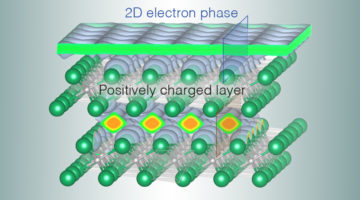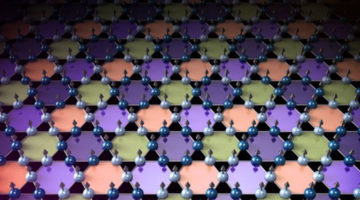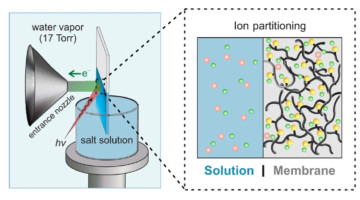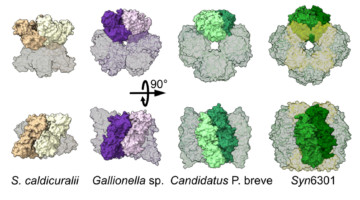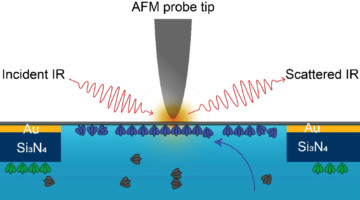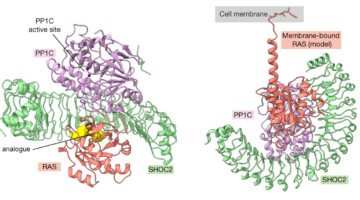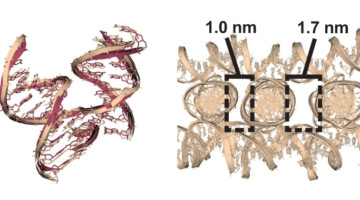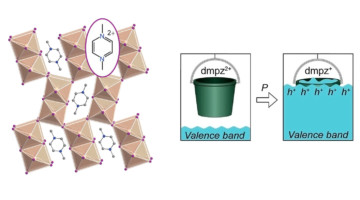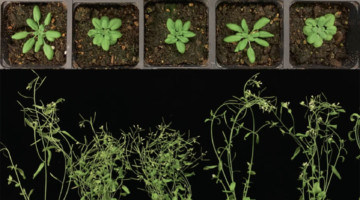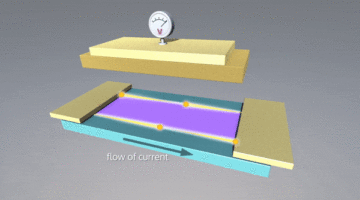Researchers discovered a liquid-like layer of electrons that floats on the surface of an unusual crystal and appears to undergo a phase transition upon doping. The system is an ideal platform for studying exotic phenomena involving electrons (e.g. superconductivity) without complications arising from other types of interactions. Read more »![]()
![]()
Charge Density Wave Found in Magnetic Kagome Crystal
Researchers discovered a wave-like charge order in a magnetic material with a “kagome” geometric structure and obtained clues to the order’s origins in the material’s electronic structure. By helping to connect certain structures with emergent quantum properties, the work brings us a step closer to the goal of creating materials by design. Read more »![]()
![]()
First Direct Measurement of Elusive Donnan Potential
Researchers performed the first direct measurement of the Donnan electrical potential, which arises from an imbalance of charges at membrane-solution interfaces. Considered unmeasurable for over a century, the Donnan potential is relevant to a wide range of fields, from cell biology to energy storage and water desalination. Read more »![]()
![]()
Protein Assemblies Show Surprising Variability
Protein-structure studies performed in part at the ALS helped researchers discover that the protein assemblies in a key carbon-cycling enzyme can rearrange with surprising ease. The findings raise the prospect of genetically tuning the protein in agricultural plant species to produce more productive and resource-efficient crops. Read more »![]()
![]()
A Nano-IR Probe for Proteins in Liquid Environments
A new technique using infrared (IR) light revealed how the self-assembly of proteins is affected by environmental conditions in a surrounding liquid. This nanoscale probe of soft matter in a liquid matrix will facilitate advances in biology, plastics processing, and energy-relevant applications such as electrocatalysts and batteries. Read more »![]()
![]()
Structures Signal Fresh Targets for Anticancer Drugs
Researchers from Genentech used a suite of methods, including small-angle x-ray scattering, to learn how an assembly of three proteins works together to transmit signals for cell division. The work reveals new targets for the development of drugs that fight certain types of cancer, including lung, colorectal, and pancreatic cancer. Read more »![]()
![]()
An Expanded Set of DNA Building Blocks for 3D Lattices
Researchers studied 36 DNA-based molecular junctions and discovered factors that yield superior self-assembled 3D lattice structures. The work expands the set of building blocks for lattices that can scaffold molecules into regular arrays, from proteins for structure studies to nanoparticles for nano-antennas and single-particle sensors. Read more »![]()
![]()
Hybrid Semiconductors Perform Under Pressure
Researchers found that compressing hybrid (organic–inorganic) semiconductors significantly boosts their conductivity. The work demonstrates a novel doping mechanism in which the material’s organic molecules serve as charge reservoirs for tuning charge-carrier concentration, with promising applications in solar cells, lasers, and LEDs. Read more »![]()
![]()
Molecular Switch Triggers Changes in Plant Structure
Using x-ray crystallography, biochemistry, and plant genetics, researchers identified a molecular switch that triggers modifications to plant structure in response to environmental conditions. A greater understanding of this adaptive process will help scientists optimize plants for efficient nutrient uptake and resistance to parasitic species. Read more »![]()
![]()
A Topological-Insulator Sandwich for Efficient Microelectronics
Researchers synthesized a topological insulator between two ferromagnetic layers and found that it is electronically characterized by a large magnetic band gap. The results open a new path toward lossless charge transport and perfect spin polarization, which could lead to the development of ultralow-energy electronics and spintronics. Read more »![]()
![]()
- « Previous Page
- 1
- …
- 3
- 4
- 5
- 6
- 7
- …
- 13
- Next Page »
